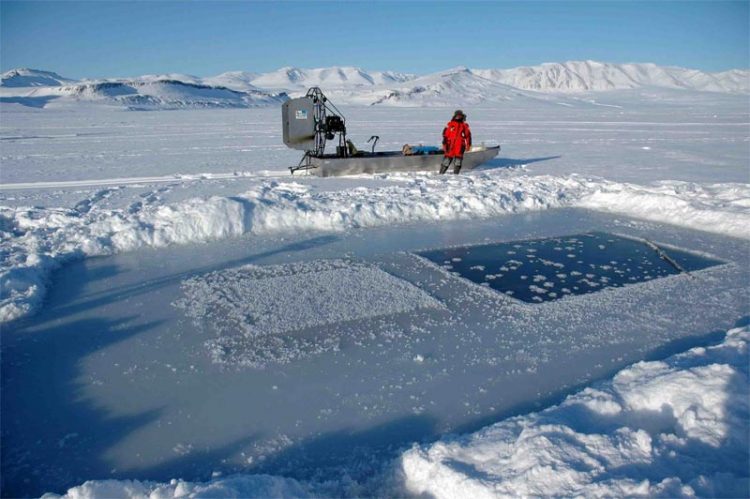Arctic sea ice helps remove CO2 from the atmosphere

Dorte Haubjerg Søgaard from University of Denmark/Grønlands Naturinstitut studies how sea ice removes CO2 from the atmosphere. Photo: Søren Rysgaard.
Due to global warming, larger and larger areas of sea ice melt in the summer and when sea ice freezes over in the winter it is thinner and more reduced. As the Arctic summers are getting warmer we may see an acceleration of global warming, because reduced sea ice in the Arctic will remove less CO2 from the atmosphere, Danish scientists report.
“If our results are representative, then sea ice plays a greater role than expected, and we should take this into account in future global CO2 budgets”, says Dorte Haubjerg Søgaard, PhD Fellow, Nordic Center for Earth Evolution, University of Southern Denmark and the Greenland Institute of Natural Resources, Nuuk.
Sea ice draws CO2 from the atmosphere
Only recently scientists have realized that sea ice has an impact on the planet's CO2 balance.
“We have long known that the Earth's oceans are able to absorb huge amounts of CO2. But we also thought that this did not apply to ocean areas covered by ice, because the ice was considered impenetrable. However, this is not true: New research shows that sea ice in the Arctic draws large amounts of CO2 from the atmosphere into the ocean”, says Dorte Haubjerg Søgaard.
Dorte Haubjerg Søgaard has just completed her studies of sea ice in Greenland. The studies show that sea ice may have a major impact on the global carbon cycle, and that chemical processes have a much greater impact on the sea ice's ability to remove CO2 than biological processes. The research is published as a series of articles in scientific journals.
“The chemical removal of CO2 in sea ice occurs in two phases. First crystals of calcium carbonate are formed in sea ice in winter. During this formation CO2 splits off and is dissolved in a heavy cold brine, which gets squeezed out of the ice and sinks into the deeper parts of the ocean. Calcium carbonate cannot move as freely as CO2 and therefore it stays in the sea ice. In summer, when the sea ice melts, calcium carbonate dissolves, and CO2 is needed for this process. Thus, CO2 gets drawn from the atmosphere into the ocean – and therefore CO2 gets removed from the atmosphere”, explains Dorte Haubjerg Søgaard.
The biological removal of CO2 is done by algae binding of carbon in organic material.
Frost flowers also contribute
Another important discovery is that every winter flower-like ice formations are formed on the surface of newly formed sea ice. They are called frost flowers. Dorte Haubjerg Søgaard has discovered that these frost flowers hold extremely high concentrations of calcium carbonate, which can have a further significant impact on the potential CO2 uptake in the Arctic.
Contact
Ph.d. Dorte Haubjerg Søgaard, Tel: +299321200 and doso@natur.gl.
Ref:
The relative contributions of biological and abiotic processes to carbon dynamics in subarctic sea ice, Polar Biology: Dorte Haubjerg Søgaard, David N. Thomas, Søren Rysgaard, Ronnie Nøhr Glud, Louiza Norman, Hermanni Kaartokallio, Thomas Juul-Pedersen, Nicolas-Xavier Geilfus. doi 10.1007/s00300-013-1396-3.
Media Contact
All latest news from the category: Earth Sciences
Earth Sciences (also referred to as Geosciences), which deals with basic issues surrounding our planet, plays a vital role in the area of energy and raw materials supply.
Earth Sciences comprises subjects such as geology, geography, geological informatics, paleontology, mineralogy, petrography, crystallography, geophysics, geodesy, glaciology, cartography, photogrammetry, meteorology and seismology, early-warning systems, earthquake research and polar research.
Newest articles

NASA: Mystery of life’s handedness deepens
The mystery of why life uses molecules with specific orientations has deepened with a NASA-funded discovery that RNA — a key molecule thought to have potentially held the instructions for…

What are the effects of historic lithium mining on water quality?
Study reveals low levels of common contaminants but high levels of other elements in waters associated with an abandoned lithium mine. Lithium ore and mining waste from a historic lithium…

Quantum-inspired design boosts efficiency of heat-to-electricity conversion
Rice engineers take unconventional route to improving thermophotovoltaic systems. Researchers at Rice University have found a new way to improve a key element of thermophotovoltaic (TPV) systems, which convert heat…



